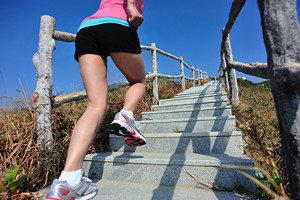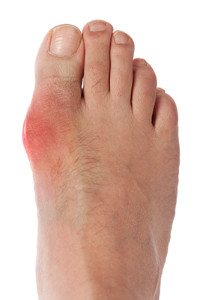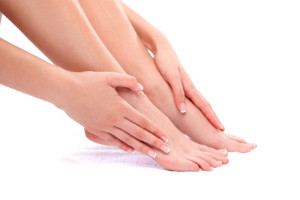
 If you are experiencing scaly and peeling skin, itchiness, and redness on the soles of the feet or in between the toes, you may have athlete's foot. Athlete's foot, also known as "jungle rot" to military service members, is a fungal infection of the foot. In some cases, small blisters can form and pain can be present as well. The fungus can be contagious and can come from many sources, including gyms, locker rooms, swimming pools, public showers, nail salons, and contaminated clothing. Topical creams are a common treatment for this condition, however, seeing a podiatrist is often a better option. Above all, prevention is the best method to stop athlete's foot which means keeping the feet dry and protected from certain environments. Tips on how to prevent athlete's foot include: wearing sweat-absorbent socks, breathable shoes, using foot powder, washing the feet daily, and wearing shower shoes in locker rooms and showers.
If you are experiencing scaly and peeling skin, itchiness, and redness on the soles of the feet or in between the toes, you may have athlete's foot. Athlete's foot, also known as "jungle rot" to military service members, is a fungal infection of the foot. In some cases, small blisters can form and pain can be present as well. The fungus can be contagious and can come from many sources, including gyms, locker rooms, swimming pools, public showers, nail salons, and contaminated clothing. Topical creams are a common treatment for this condition, however, seeing a podiatrist is often a better option. Above all, prevention is the best method to stop athlete's foot which means keeping the feet dry and protected from certain environments. Tips on how to prevent athlete's foot include: wearing sweat-absorbent socks, breathable shoes, using foot powder, washing the feet daily, and wearing shower shoes in locker rooms and showers.
Athlete’s foot is an inconvenient condition that can be easily reduced with the proper treatment. If you have any concerns about your feet, contact Dr. Robert Hope from Riverside Podiatry. Our doctor will treat your foot needs.
Athlete’s Foot: The Sole Story
Athlete's foot, also known as tinea pedis, can be an extremely contagious foot infection. It is commonly contracted in public changing areas and bathrooms, dormitory style living quarters, around locker rooms and public swimming pools, or anywhere your feet often come into contact with other people.
Solutions to Combat Athlete’s Foot
Athlete’s foot can cause many irritating symptoms such as dry and flaking skin, itching, and redness. Some more severe symptoms can include bleeding and cracked skin, intense itching and burning, and even pain when walking. In the worst cases, Athlete’s foot can cause blistering as well. Speak to your podiatrist for a better understanding of the different causes of Athlete’s foot, as well as help in determining which treatment options are best for you.
If you have any questions please feel free to contact our office located in Tuscaloosa, and Fayette, AL . We offer the newest diagnostic and treatment technologies for all your foot needs.
Read more about Athlete's Foot Running can be a great way to stay healthy, however it can also lead to injuries. Knowing what to do to prevent running injuries is essential to ensure a healthy outcome. In addition to basic steps like drinking plenty of water, avoiding overuse, running properly, and wearing the right footwear for you, there are more advanced steps you can take to help prevent injury. Stretching daily, even during down times like at a work, helps keep the body loose. Working out both legs individually can help ensure that each leg is strong on its own. Stability exercises, even ones as simple as balancing on one leg, and strength and flexibility exercises can help promote overall fitness that makes the body more resilient to injury. Following these steps won’t prevent every injury, but they can help significantly.
Running can be a great way to stay healthy, however it can also lead to injuries. Knowing what to do to prevent running injuries is essential to ensure a healthy outcome. In addition to basic steps like drinking plenty of water, avoiding overuse, running properly, and wearing the right footwear for you, there are more advanced steps you can take to help prevent injury. Stretching daily, even during down times like at a work, helps keep the body loose. Working out both legs individually can help ensure that each leg is strong on its own. Stability exercises, even ones as simple as balancing on one leg, and strength and flexibility exercises can help promote overall fitness that makes the body more resilient to injury. Following these steps won’t prevent every injury, but they can help significantly.
Exercising your feet regularly with the proper foot wear is a great way to prevent injuries. If you have any concerns about your feet, contact Dr. Robert Hope of Riverside Podiatry. Our doctor will treat your foot needs.
How to Prevent Running Injuries
Many common running injuries are caused by overuse and overtraining. When the back of the kneecap starts wearing out and starts causing pain in your knee, this is commonly referred to as runner’s knee. Runner’s knee is a decrease in strength in your quadriceps and can occur if you’re not wearing properly fitted or supporting shoes. To prevent runner’s knee, focusing on hip strengthening is a good idea, as well as strengthening your quads to keep the kneecaps aligned.
What Are Some Causes of Running Injuries?
- One cause of a common running injury is called iliotibial band syndrome.
- Plantar fasciitis is also another common injury.
- Stress fractures can occur from overtraining, lack of calcium, or even your running style.
Best Ways to Prevent Running Injuries
- Wear footwear that fits properly and suits your running needs.
- Running shoes are the only protective gear that runners have to safeguard them from injury.
- Make a training schedule. Adding strengthening exercises as well as regular stretching can help keep you strong and limber and can lessen the possibility of injuries.
- Stretching keeps muscles limber; this will help you gain better flexibility.
If you have any questions please feel free to contact our office located in Tuscaloosa, and Fayette, AL . We offer the newest diagnostic and treatment technologies for all your foot needs.
Read more about How to Prevent Running Injuries Gout, a form of arthritis, is a common, painful disorder caused by a buildup of uric acid crystals in the joints. It can occur in any joint in the body, including joints in the foot. Symptoms include pain, inflammation, and redness at the affected area. Gout generally occurs as attacks that come and go. Men often suffer from gout more than women, and attacks are more likely to come during the night. Anti-inflammatory medications or corticosteroids can help reduce pain and inflammation, and changes in diet have been found to help lessen the risk of attacks. Alcoholic beverages and foods that are rich in purines should be avoided. If you are experiencing gout symptoms in the foot, it is recommended to see a podiatrist for treatment.
Gout, a form of arthritis, is a common, painful disorder caused by a buildup of uric acid crystals in the joints. It can occur in any joint in the body, including joints in the foot. Symptoms include pain, inflammation, and redness at the affected area. Gout generally occurs as attacks that come and go. Men often suffer from gout more than women, and attacks are more likely to come during the night. Anti-inflammatory medications or corticosteroids can help reduce pain and inflammation, and changes in diet have been found to help lessen the risk of attacks. Alcoholic beverages and foods that are rich in purines should be avoided. If you are experiencing gout symptoms in the foot, it is recommended to see a podiatrist for treatment.
Gout is a foot condition that requires certain treatment and care. If you are seeking treatment, contact Dr. Robert Hope from Riverside Podiatry. Our doctor will treat your foot needs.
What Is Gout?
Gout is a type of arthritis caused by a buildup of uric acid in the bloodstream. It often develops in the foot, especially the big toe area, although it can manifest in other parts of the body as well. Gout can make walking and standing very painful and is especially common in diabetics and the obese.
People typically get gout because of a poor diet. Genetic predisposition is also a factor. The children of parents who have had gout frequently have a chance of developing it themselves.
Gout can easily be identified by redness and inflammation of the big toe and the surrounding areas of the foot. Other symptoms include extreme fatigue, joint pain, and running high fevers. Sometimes corticosteroid drugs can be prescribed to treat gout, but the best way to combat this disease is to get more exercise and eat a better diet.
If you have any questions please feel free to contact our office located in Tuscaloosa, and Fayette, AL . We offer the newest diagnostic and treatment technologies for all your foot needs.
Read more about Everything You Need to Know About Gout There are a great number of common foot ailments that can affect anyone. Here’s a small rundown on each and what to do about them. Plantar fasciitis, a common form of heel pain, is caused by the inflammation of the plantar fascia and generally occurs from overuse. Rest and wearing good footwear can help the pain go away, however, it is best to see a podiatrist for treatment. Flat feet are often treated by a podiatrist who can offer the best forms of appropriate treatment such as custom-made orthotics. Heel spurs are calcium deposits that form beneath the heel bones, potentially causing severe pain. Anti-inflammatory medications, exercise, and orthotics can help treat heel spurs; however, surgery may be necessary in some cases. Calluses, or thick patches of skin caused by friction, can be taken care of by eliminating sources of friction against the foot and moisturizing. For athletes and runners, spraining and straining the foot are always a possibility. Icing the foot, rest, and seeing a podiatrist are the best methods of treatment. Bunions are bony protrusions at the base of the big toe and can be exacerbated by poor footwear, such as heels. Once again, seeing a podiatrist is the best way to get treatment. Finally, ingrown toenails are a common condition and can be prevented by cutting your nails straight across and wearing shoes that give the toes ample space to move.
There are a great number of common foot ailments that can affect anyone. Here’s a small rundown on each and what to do about them. Plantar fasciitis, a common form of heel pain, is caused by the inflammation of the plantar fascia and generally occurs from overuse. Rest and wearing good footwear can help the pain go away, however, it is best to see a podiatrist for treatment. Flat feet are often treated by a podiatrist who can offer the best forms of appropriate treatment such as custom-made orthotics. Heel spurs are calcium deposits that form beneath the heel bones, potentially causing severe pain. Anti-inflammatory medications, exercise, and orthotics can help treat heel spurs; however, surgery may be necessary in some cases. Calluses, or thick patches of skin caused by friction, can be taken care of by eliminating sources of friction against the foot and moisturizing. For athletes and runners, spraining and straining the foot are always a possibility. Icing the foot, rest, and seeing a podiatrist are the best methods of treatment. Bunions are bony protrusions at the base of the big toe and can be exacerbated by poor footwear, such as heels. Once again, seeing a podiatrist is the best way to get treatment. Finally, ingrown toenails are a common condition and can be prevented by cutting your nails straight across and wearing shoes that give the toes ample space to move.
Everyday foot care is very important to prevent infection and other foot ailments. If you need your feet checked, contact Dr. Robert Hope from Riverside Podiatry. Our doctor can provide the care you need to keep you pain-free and on your feet.
Everyday Foot Care
Often, people take care of their bodies, face and hair more so than they do for their feet. But the feet are a very important aspect of our bodies, and one that we should pay more attention to. Without our feet, we would not be able to perform most daily tasks.
It is best to check your feet regularly to make sure there are no new bruises or cuts that you may not have noticed before. For dry feet, moisturizer can easily be a remedy and can be applied as often as necessary to the affected areas. Wearing shoes that fit well can also help you maintain good foot health, as well as making it easier to walk and do daily activities without the stress or pain of ill-fitting shoes, high heels, or even flip flops. Wearing clean socks with closed shoes is important to ensure that sweat and bacteria do not accumulate within the shoe. Clean socks help to prevent Athlete’s foot, fungi problems, bad odors, and can absorb sweat.
If you have any questions please feel free to contact our office located in Tuscaloosa, and Fayette, AL . We offer the newest diagnostic and treatment technologies for all your foot needs.
Read more about Every Day Foot Care